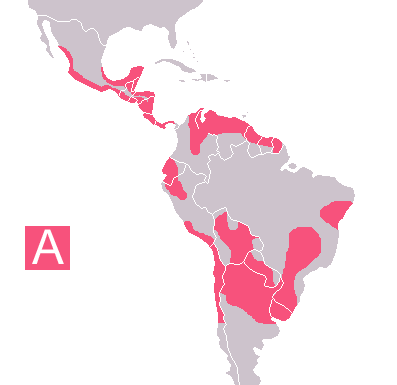Chagas disease epidemiology and demographics
Editor-In-Chief: C. Michael Gibson, M.S., M.D. [1]
|
Chagas disease Microchapters |
|
Diagnosis |
|---|
|
Treatment |
|
Case Studies |
|
Chagas disease epidemiology and demographics On the Web |
|
American Roentgen Ray Society Images of Chagas disease epidemiology and demographics |
|
Risk calculators and risk factors for Chagas disease epidemiology and demographics |
Overview
Epidemiology and geographical distribution

Chagas' disease currently affects 16–18 million people, with some 100 million (25% of the Latin American population) at risk of acquiring the disease,[1] killing around 50,000 people annually.[2] Chronic Chagas' disease remains a major health problem in many Latin American countries, despite the effectiveness of hygienic and preventive measures, such as eliminating the transmitting insects, which have reduced to zero new infections in at least two countries of the region. With increased population movements, however, the possibility of transmission by blood transfusion has become more substantial in the United States.[3] Approximately 500,000 infected people live in the USA, virtually all of them immigrants.[4] Also, T. cruzi has already been found infecting wild opossums and raccoons as far north as the state of North Carolina.[5] Although there are triatomine bugs in the U.S., only rare vectorborne cases of Chagas disease have been documented.
The disease is distributed in the Americas, ranging from the southern United States to southern Argentina, mostly in poor, rural areas of Central and South America.[6]
The disease is almost exclusively found in rural areas, where the Triatominae can breed and feed on the natural reservoirs (the most common ones being opossums and armadillos) of T.cruzi. Depending on the special local interactions of the vectors and their hosts, other infected humans, domestic animals like cats, dogs, guinea pigs and wild animals like rodents, monkeys, ground squirrels (Spermophilus beecheyi) and many others could also serve as important parasite reservoirs. Though Triatominae bugs feed on birds, these seem to be immune against infection and therefore are not considered to be a T. cruzi reservoir; but there remain suspicions of them being a feeding resource for the vectors near human habitations.
The triatomine insects are known popularly in the different countries as vinchuca, barbeiro (the barber), chipo and other names,[1] so called because it sucks the blood at night by biting the face of its victims. The insects, who develop a predominantly domiciliary and anthropophilic behaviour once they have infested a house,[7] usually hide during the day in crevices and gaps in the walls and roofs of poorly constructed homes. More rarely, better constructed houses may harbor the insect vector, because of the use of rough materials for making roofs, such as bamboo and thatch. A mosquito net, wrapped under the mattress, will provide protection in these situations, when the adult insect might sail down from above, but one of the five nymphal stages (instars) could crawl up from the floor.
Even when the colonies of insects are eradicated from a house and surrounding domestic animal shelters, they can arrive again (e.g., by flying) from plants or animals that are part of the ancient, natural sylvatic infection cycle. This can happen especially in zones with mixed open savannah, clumps of trees, etc., interspersed by human habitation.
Dense vegetation, like in tropical rain forests, and urban habitats, are not ideal for the establishment of the human transmission cycle. However, in regions where the sylvatic habitat and its fauna are thinned out by economical exploitation and human habitation, such as in newly deforested, piassava palm (Leopoldinia piassaba) culture areas, and some parts of the Amazon region, this may occur, when the insects are searching for new prey.[8]
References
- ↑ 1.0 1.1
- ↑ Carlier, Yves. Chagas Disease (American Trypanosomiasis). eMedicine (27 February 2003).
- ↑ Kirchhoff LV. "American trypanosomiasis (Chagas disease)—a tropical disease now in the United States." N Engl J Med. 1993 August 26;329(9):639-44. PMID 8341339 Online.
- ↑ National Institutes of Health. Medical Encyclopedia Accessed 9/25/2006
- ↑ Karsten V, Davis C, Kuhn R. "Trypanosoma cruzi in wild raccoons and opossums in North Carolina." J Parasitol. 1992 Jun;78(3):547-9. PMID 1597808
- ↑ Centers for Disease Control (CDC). American Trypanosomyasis Fact Sheet. Accessed 24 September 2006.
- ↑ Grijalva MJ, Palomeque-Rodriguez FS, Costales JA, et al. "High household infestation rates by synanthropic vectors of Chagas disease in southern Ecuador." J Med Entomol. 2005 Jan;42(1):68–74. PMID 15691011
- ↑ Teixeira AR, Monteiro PS, Rebelo JM, et al. "Emerging Chagas Disease: Trophic Network and Cycle of Transmission of Trypanosoma cruzi from Palm Trees in the Amazon." Emerg Infect Dis. 2001 Jan-Feb;7(1):100-12. PMID 11266300. PDF full text.